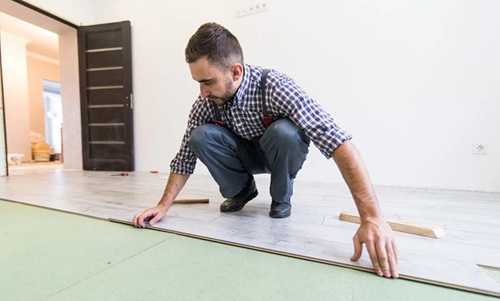When it comes to updating flooring, homeowners and renovators often look for solutions that are both cost-effective and time-saving. One increasingly popular method is laying vinyl flooring over existing tile. Vinyl flooring, whether in planks, sheets, or tiles, is known for its durability, affordability, and ease of installation. But does installing it directly over tile offer real advantages—or potential pitfalls?
This article provides a fact-based analysis of the pros and cons of laying vinyl over tile, helping you decide whether this approach is the right one for your flooring project.
Understanding the Process

Before diving into the pros and cons, it’s important to understand what this method entails. Laying vinyl over tile means applying luxury vinyl plank (LVP), luxury vinyl tile (LVT), or sheet vinyl directly on top of an existing ceramic or porcelain tiled floor. This can be done using click-lock floating systems, peel-and-stick options, or glue-down methods, depending on the vinyl type.
However, not all tile floors are created equal. For best results, the tile should be:
- Level and structurally sound
- Clean and free of moisture
- Without major cracks or loose tiles
If the conditions are right, installing vinyl over tile can be a smart and efficient solution.
Pros of Laying Vinyl Over Tile
1. Time and Labor Savings
The biggest advantage is avoiding the demolition of existing tile. Tearing out ceramic tile can be labor-intensive, messy, and costly. By laying vinyl over the top, you skip the time-consuming removal process, saving both effort and money.
2. Cost-Effective Renovation
Since you’re not removing the tile, there are lower labor costs and no disposal fees. Vinyl itself is also one of the most affordable flooring materials on the market, making it a smart choice for budget-conscious homeowners.
3. Easy Installation
Vinyl is known for being DIY-friendly, especially click-lock and peel-and-stick varieties. If the tile is level and intact, installing vinyl on top is generally straightforward, even for novice renovators.
4. Modern Aesthetic Upgrade
Old tile can make a space feel dated. Vinyl comes in a wide range of modern finishes, including realistic wood, stone, and ceramic-look patterns. Laying vinyl over tile allows for a quick aesthetic upgrade without a full remodel.
5. Added Insulation and Comfort
Vinyl is softer and warmer underfoot compared to tile. Laying it over tile adds a layer of cushioning, which can make walking more comfortable, especially in kitchens and bathrooms where people tend to stand for longer periods.
6. Waterproof Options
Many modern vinyl products are 100% waterproof, making them suitable for moisture-prone areas like bathrooms, kitchens, and basements. Installing waterproof vinyl over tile can improve a floor’s moisture resistance, assuming the original tile floor is dry and sealed.
7. Low Maintenance
Once installed, vinyl requires minimal maintenance. It’s easy to clean, stain-resistant, and doesn’t need waxing or sealing, unlike some natural flooring materials.
Cons of Laying Vinyl Over Tile
1. Uneven Subfloor Issues
If the existing tile floor has deep grout lines, cracks, or uneven tiles, these imperfections can telegraph through the vinyl, creating bumps or uneven surfaces. This can compromise the appearance and durability of the new floor.
Solution: Use a self-leveling compound to fill in grout lines and level out the surface before installation.
2. Height and Clearance Concerns
Adding a vinyl layer increases the floor height slightly. While vinyl is thin, when placed over existing tile, it may:
- Interfere with door clearances
- Affect transitions to adjacent rooms
- Require trimming doors or modifying thresholds
3. Risk of Moisture Traps
If the tile floor has any hidden moisture issues, laying vinyl over it can trap that moisture, leading to mold, mildew, or adhesive failure over time. This is especially risky in basements or bathrooms with poor ventilation.
Solution: Ensure the tile floor is completely dry, and consider a vapor barrier or moisture-resistant vinyl option.
4. Longevity and Warranty Considerations
Some manufacturers may void warranties if vinyl is installed over tile, especially if the tile isn’t properly prepared. Improper installation may lead to premature wear or lifting, particularly in high-traffic areas.
5. Difficult Repairs
If a problem arises under the vinyl—such as a tile crack causing movement—it can be difficult to repair without pulling up sections of the vinyl. Additionally, glue-down installations can be harder to remove if you change your mind later.
6. Not Ideal for Severely Damaged Tile
If the tile floor is cracked, loose, or uneven beyond repair, vinyl should not be laid over it. Doing so may worsen structural problems and lead to costly repairs down the line.
Best Practices for Success
To ensure the best outcome when laying vinyl over tile, follow these key steps:
- Inspect the tile: Make sure it’s secure, level, and free of moisture.
- Fill grout lines: Use leveling compound to create a flat surface.
- Clean thoroughly: Remove any dust, oils, or residues before laying the vinyl.
- Use an underlayment: If recommended by the vinyl product, especially for click-lock floors.
- Check door clearances: Trim doors if necessary to accommodate the new floor height.
Conclusion: Is It Worth It?
Laying vinyl over tile is a practical, efficient, and often cost-effective solution for many homeowners looking to refresh their floors without major renovation. With proper preparation, it can result in a durable, stylish, and comfortable floor that holds up well over time.
However, the key to success lies in the condition of the existing tile and the quality of installation. If your tile floor is flat, dry, and intact, vinyl is a viable and smart upgrade. But if the tile is damaged, uneven, or moisture-prone, it’s best to address those issues first—or consider removing the tile altogether.
In summary, vinyl-over-tile installation can be a flooring win—when done with planning, precision, and proper prep work.

